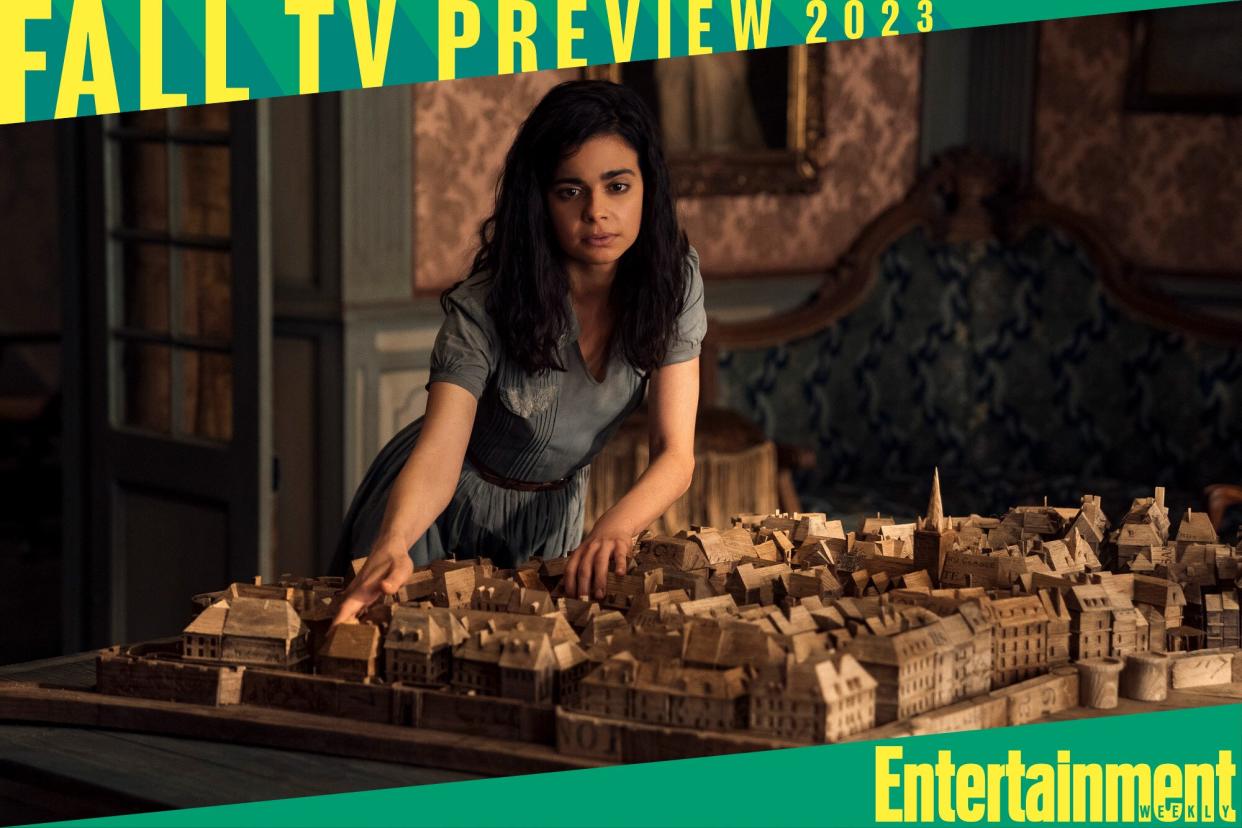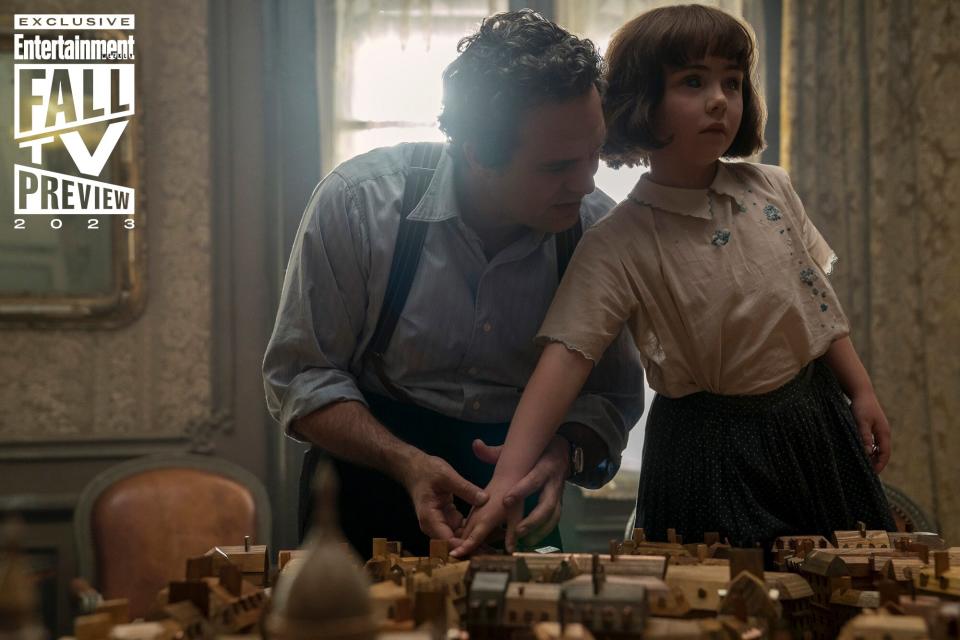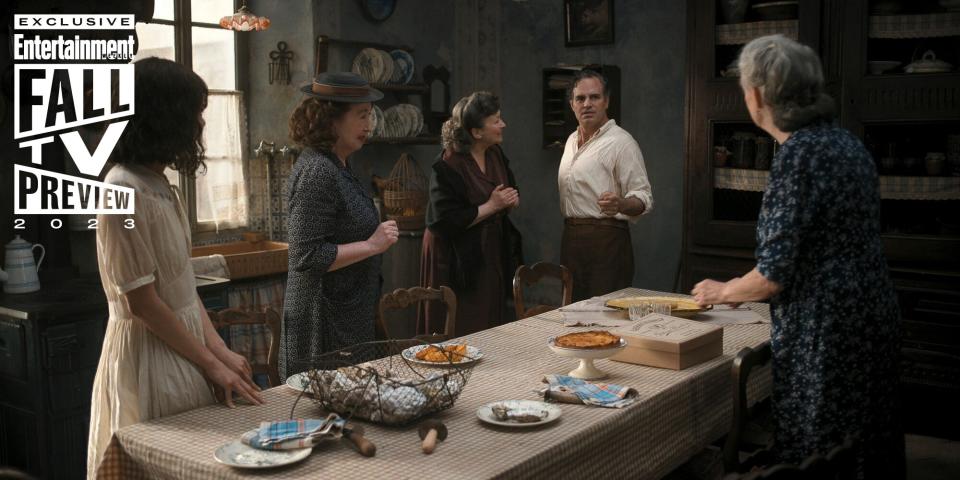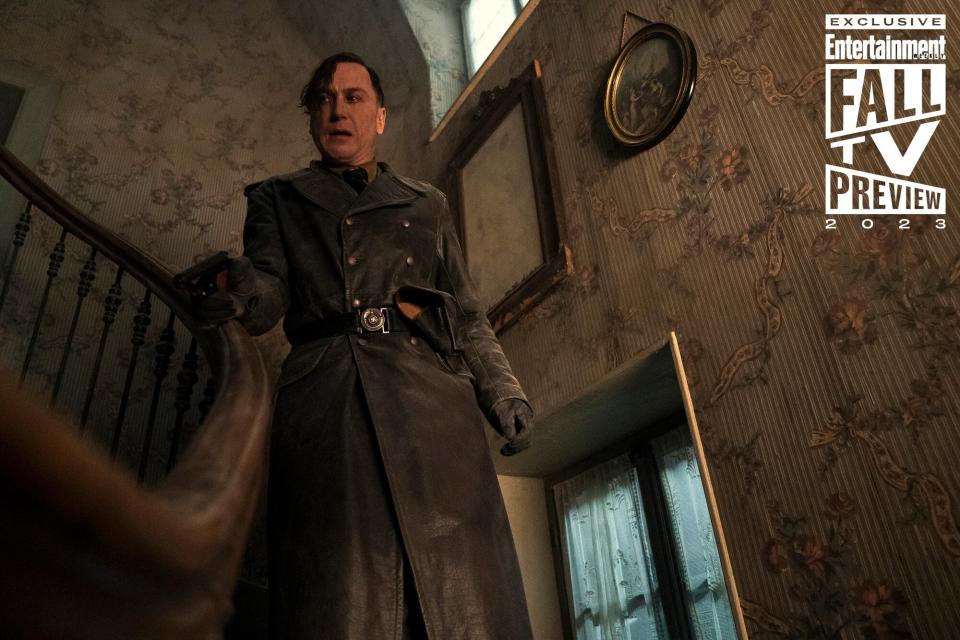Page to screen: “All the Light We Cannot See” director breaks down 5 key scenes

- Oops!Something went wrong.Please try again later.
- Oops!Something went wrong.Please try again later.
- Oops!Something went wrong.Please try again later.
- Oops!Something went wrong.Please try again later.
Atsushi Nishijima/Netflix Aria Mia Loberti as Marie-Laure in 'All the Light We Cannot See'
When filmmaker Shawn Levy (The Adam Project, Deadpool 3) met Anthony Doerr, the Pulitzer Prize-winning author of All the Light We Cannot See, his perspective on the limited series adaptation instantly changed. A rabid fan (like so many others) of the 2014 World War II-set best-selling novel, Levy and his production company, 21 Laps, had been pursuing the screen rights, which he says were "instantly unavailable." But they had kept tabs on the previous movie version of the novel, and when that didn't come together, he called up Doerr.
"Talking to that guy was fascinating," Levy recalls to EW, Zooming in from his New York home in early August. "He's a very warm, enthusiastic man, and he was just so beautifully thrilled to see his story getting another life, this time on screen. What I got from him is that the genesis of this story wasn't blindness, as some people assume, given the title. It was the radio."
All the Light We Cannot See tells of the converging paths of Marie-Laure LeBlanc, a blind French teen who's forced to flee Paris with her father as the Nazis invade, and Werner Pfennig, a German orphan with a natural affinity for radios who's forcibly indoctrinated into the Reich to track down illegal broadcasts. The book, Levy continues, comes from "this notion that the human eye can only see one 10-trillionth of all the light in the universe, and that as humans we're ultimately limited in what we can perceive. But the advent of radio, which was on the one hand a tool of propaganda for the Nazis, was also a way of sharing truth and beauty and information — not to mention codes [from those] that believed the world could be better. It was very interesting to me and maybe not what I would've thought quite as much about were it not for conversations with [Doerr]."
Levy discusses five key scenes from the novel that he brought to life on screen for the four-part miniseries adaptation (on Netflix Nov. 2) that speak to the heart of this moving story.
The model of Paris

Courtesy of Netflix Mark Ruffalo as Daniel LeBlanc and Nell Sutton as young Marie-Laure in 'All the Light We Cannot See'
Touch often links to memory in the storytelling of All the Light We Cannot See. In one particular sequence early in the drama, Marie-Laure (Aria Mia Loberti) runs her hands across a wooden model of St. Malo as a means of mapping out the area in her mind. She fled to this oceanside city with her father, Daniel LeBlanc (Mark Ruffalo), and now resides at the home of her uncle, Etienne (Hugh Laurie). Feeling the model triggers a memory of how her dad once built a similar model of Paris for her as a child so that, if they were to ever separate or she were to venture out alone, she could find her way around. The sequence begins with a grown-up Marie-Laure feeling her way through St. Malo as the camera then transitions to the flashback of her younger self (Nell Sutton) learning her way around Paris with her father.
"I want to stress that these are not 3D printed," Levy states. "This model of Paris and later the model of St. Malo are arguably the most iconic objects from the novel. So, we had craftsmen in Hungary build both by hand. And if you look at the close-ups, the wood would've had to be sourced from wine crates and discarded trash. So, this is not planks and Balsa wood. This is reclaimed wood that these carpenters honed and edged and hot-glued and turned into these magnificent models. The first time that both Aria and Nell navigated these models with their fingers was goosebumps all around."
More than that, Levy considers these wooden models to be "totems of the love and devotion" Daniel feels for his daughter. He built them to foster Marie-Laure's autonomy and independence, regardless of sight. "The father-daughter relationship, more generally, resonated for me powerfully in the book," the filmmaker says. "I knew, especially if I was gonna direct every episode, that the father-daughter connection and love would be at the core of the storytelling."
Werner's journey begins

Courtesy of Netflix Louis Hofmann as Werner Pfennig, Ed Skrein as Ed Siedler, and Luna Wedler as Jutta in 'All the Light We Cannot See'
The start of Werner's (Louis Hofmann) story is similarly marked by violence. His life is forever altered when Herr Siedler (Ed Skrein), a Nazi official, arrives at the orphanage where he and his sister, Jutta (Luna Wedler), reside. It's the moment that will lead to his induction to an elite, draconian boarding school for Hitler youth where he's brutalized and trained as a Nazi soldier.
"I remember that Luna and Louis made clear to Ed that they were comfortable with the physicality of the scene," Levy recalls of filming Siedler's arrival. "The first time that Ed clamps his gloved hand on Luna's mouth when she tries to speak up, the violence of the way he jabs his index finger into the top of Louis' head or yanks him up from that chair, there's a sudden violence to these gestures that are horrifying and important in understanding the true nature of this Siedler character. It was quite remarkable."
Siedler remains as complex a character on screen as he is in the source material. He's a relatively low-ranking Nazi official who's valuable in that he delivers young prodigies to indoctrination camps. "Werner is his passport to importance with his Nazi bosses, and that's an interesting dimension," Levy says. Though, the director also makes note of the inner turmoil he feels surrounding Werner, a boy for which he feels paternal in his own way. "What if there's a sudden surge of conscience? You can't do anything about it because it's too late. You've delivered him to the devil," Levy says. "But what if you realize now you've made a terrible, inarguable mistake? What Ed Skrein does in his eyes, clocking that conscience, is quite heartbreaking and a color that I've never seen from that actor."
This sequence is one of the few we see of Jutta, but the character's memory is precious to Werner as he embarks on the harsh journey before him. Levy notes, "Long after he is taken away by the Nazis, Jutta remains this fixture in his mind as an expectation that he would fight to preserve his better self in the face of evil and propaganda."
The Old Ladies' Resistance Club

Courtesy of Netflix Daniel LeBlanc (Mark Ruffalo) meet the Old Ladies' Resistance Club in 'All the Light We Cannot See'
There comes a time when Madame Manec (Marion Bailey), the longtime housekeeper at Etienne's residence in St. Malo, introduces Ruffalo's Daniel to the key figures behind the resistance operation in the French city. He's surprised to find that they are all women of a certain age. Levy remembers the levity that came with filming this scene, partly "because all of the baked goods that the props department brought in were actually as delicious as they look," he says.
These women comprise what is referred to as the Old Ladies' Resistance Club. It's the notion that the most overlooked residents of St. Malo are beyond suspicion, able to operate safely in the shadows. They mention how Nazi soldiers will openly tell them secrets when they bring them treats, because they remind them of their moms back home. "I think there's something aspirational about it," Levy remarks. "There's something fun about these old women who so often people in society people don't give a second thought to, but their patriotism remains fierce. Their commitment and ingenuity remains strong."
It's a crucial introductory scene because it gets to the root of All the Light We Cannot See: In the face of such dark, depressing material as the Nazis of World War II, there is still light in the form of a group of cheerful older women fighting the good fight, one baked good at a time. "I never wanted to do a pure drama. This is certainly more dramatic than any movie or show I've directed, excluding certain episodes of Stranger Things," Levy says. (The director of films like Free Guy, Real Steel, and Date Night also helmed episodes of Stranger Things, which he executive produces.) "I found the novel profound, but also wildly entertaining. I wanted our series to be both, as well: occasionally funny, specific in its characters, resonant in its themes, and ultimately moving and in some way aspirational, that hope can persist in the face of darkness."
Home invasion

Courtesy of Netflix Lars Eidinger as Sergeant Major Reinhold von Rumpel in 'All the Light We Cannot See'
Lars Eidinger has Adam Driver to thank for landing the role of Sergeant Major Reinhold von Rumpel, the Nazi officer hellbent on finding a rare jewel with rumored mystic properties. Driver had starred in Levy's 2014 dramedy This Is Where I Leave You, which also featured Jason Bateman, Tina Fey, Jane Fonda, and Rose Byrne. The Star Wars and House of Gucci actor remained friends with his filmmaker. "We hang out a few times a year," Levy says. "I was getting ready to make [All the Light We Cannot See], and Adam said to me, 'You need to know this guy, Lars Eidinger. He's doing White Noise with me right now.'"
Driver played Jack Gladney, a professor of the self-founded field of "Hitler studies," in the 2022 Noah Baumbach-directed White Noise, which also featured Eidinger as the character Mr. Gray. "No one in the U.S. has heard of him," Levy remarks of the Eidinger. "He's famous in Europe for his avant-garde Hamlet, but this guy is just a beast of an actor. I Zoomed with Lars and he read a scene, and within two lines the decision was made. He was so singular, so strange, so charming, but also scary. It was everything I wanted for Von Rumpel."
Those qualities are on display in a sequence that takes place deeper into the miniseries. On his hunt for the Sea of Flames, a cursed diamond last seen in Daniel's possession that's rumored to grant immortality, Von Rumpel tracks down Marie-Laure in Etienne's St. Malo home. She's able to barricade herself in the attic, but the Nazi stalks up the staircase, ready to claim his prey.
"Von Rumpel's desperation is ratcheted up as his health degrades," Levy explains. "Lars filmed this scene on his first day. So, his first scene was one of Von Rumpel's last scenes. He came having made choices about Von Rumpel's failing health, and he keyed off of a detail in the book that Von Rumpel has a tumor in his throat. So, Lars made this choice to almost cut off his own air right before I would say action. I would see Lars resisting breath so that by the time I said action, you felt this character's desperation for oxygen. It's uncomfortable to watch. Sometimes it's scary to watch, but that's what makes it perfect for this villain, because he's willing to do anything to get what he thinks could be the object that saves his life."
"Don't you want to be alive before you die?"

Courtesy of Netflix Hughe Laurie as Etienne LeBLanc in 'All the Light We Cannot See'
About a month before filming began, Levy reread Doerr's novel for what was perhaps the sixth time. What was different with this go-around was he did so with a highlighter. The teleplay by Steven Knight was all written at that time, but there was always an opportunity for last-minute additions. "I highlighted every time there was a description or a line of dialogue that struck me but wasn't in our show, and then Steve and I integrated them into the script before we shot," he says. One of those lines was a widely recognized piece of dialogue from the book.
Loberti's Marie-Laure is sitting at the kitchen table in St. Malo, discussing God with Madame Manec. The girl wants to know if humans see the Almighty upon their death. "What if you're blind?" she asks. Madame Manec responds, "I believe that if God wants us to see something, we'll see it." That, Levy points out, "is verbatim from the book." Shortly after, Etienne comes in, wanting to join the resistance efforts, but is paralyzed by agoraphobia. Again, Madame Manec gives a simple but world-shaping piece of advice: "Don't you want to be alive before you die?"
"I love the self-loathing that Hugh Laurie conveys, feeling so limited by his trauma," Levy explains of this exchange. "I love Madam Manec's fierce affection for him, trying to provoke him into action. I think Hugh Laurie is the s--- in this show, just so unlike we've ever seen him. And also, I really did make this show as a rabid fan of the book. I love some of the ways in which we diverged from the book, but I also love where I was able to literally integrate the things I loved into the series."
"Don't you want to be alive before you die?" has become an uplifting chant for Doerr's work. Many a book club have already unpacked the line since first reading those words. To Levy, it conjures up an image from another show he's currently obsessing over (like the rest of us), FX's The Bear — specifically, the close-up shot in season 2 of Ebon Moss-Bachrach's Richie observing a message that reads, "Every second counts."
"[It's] this reminder, this theme of we can pass the time that we're on this earth and run out the clock or we can live vigorously," Levy muses. "And that means different things to different people. For some, it's the pursuit of good or it's the pursuit of a goal. For some, it's loving and being loved as much as possible. How we define it is very personal, but this idea of being fully alive while we have the chance is relatable to all humans who have ever lived."
All the Light We Cannot See premieres Nov. 2 on Netflix.
Make sure to check out EW's Fall TV Preview cover story on Gen V — as well as all of our 2023 Fall TV Preview content, releasing through Sept. 21.
Related content:

